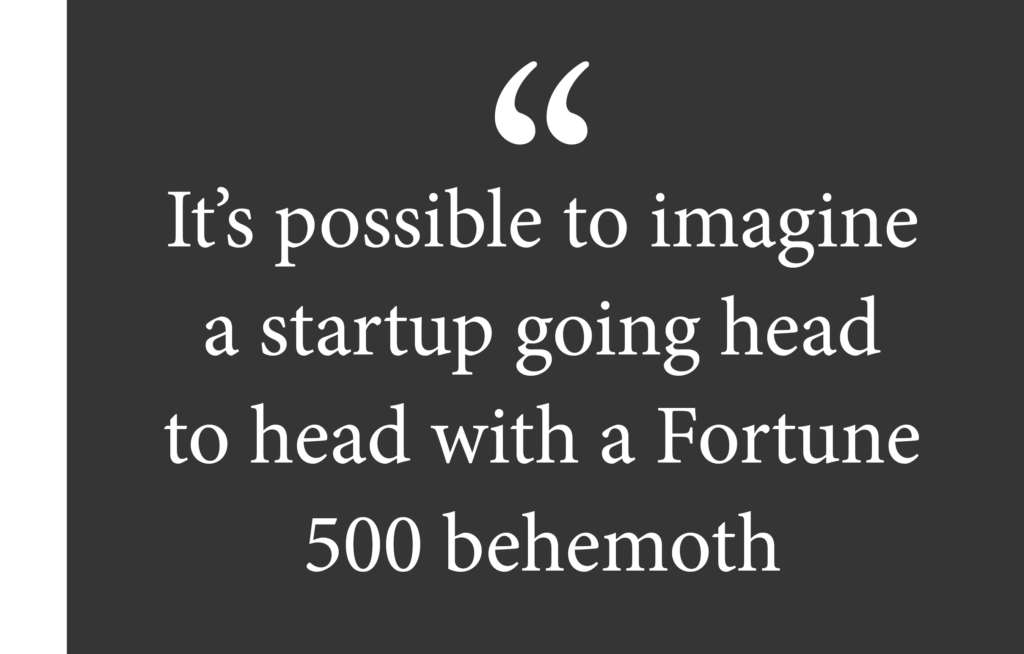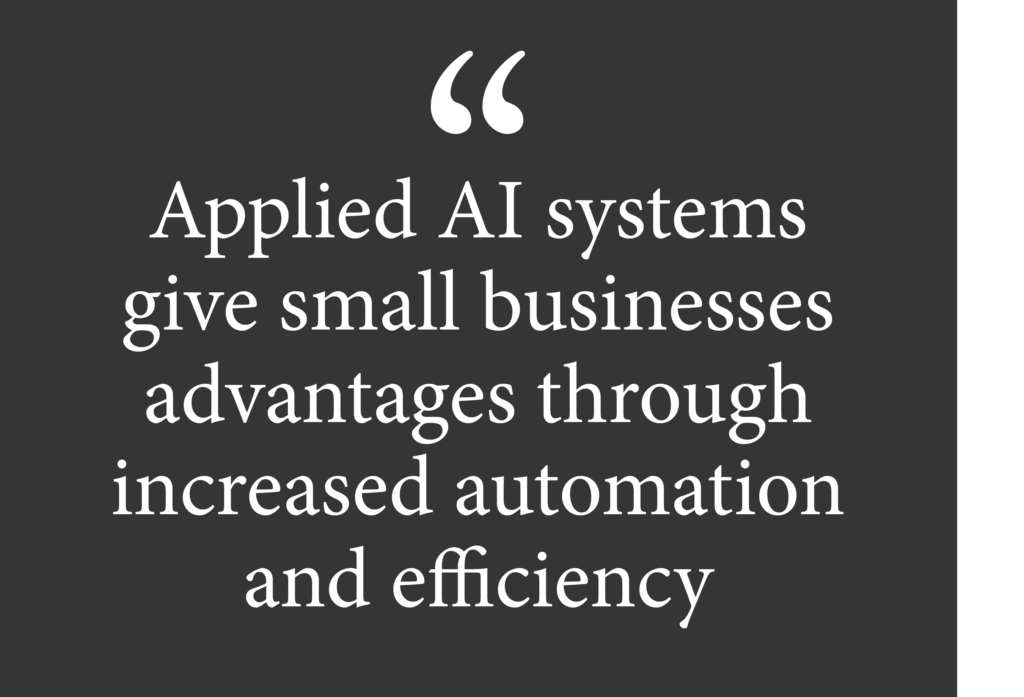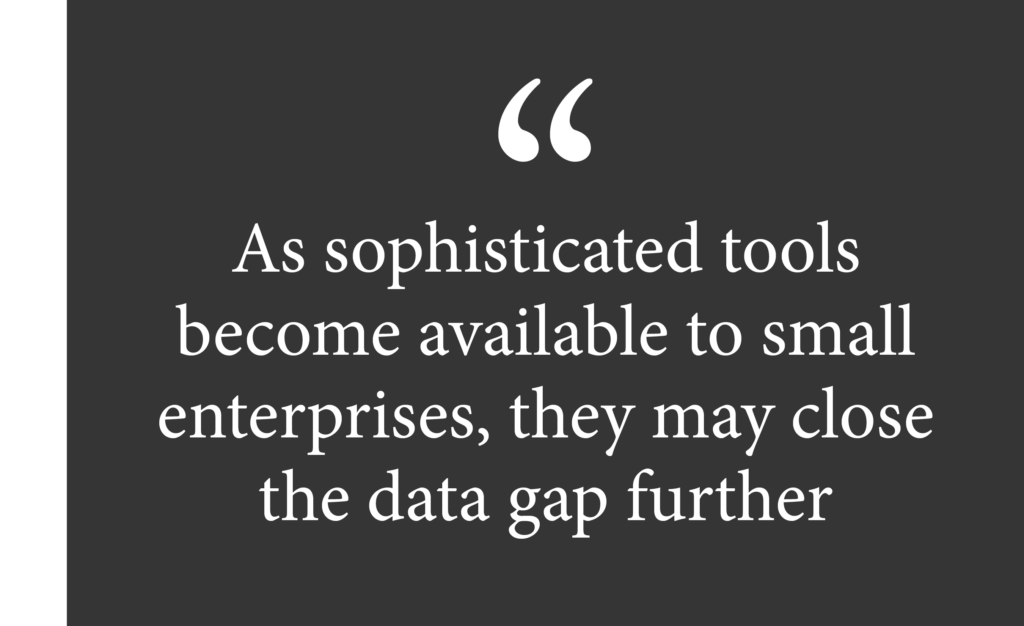People love a good David and Goliath story. Thanks to artificial intelligence, we may once again see many iterations of this narrative play out in the business space.
For a long time now, big corporations have held most of the cards. Their capital, brand recognition, large staffs, and access to data have dwarfed the resources and capabilities of small businesses. So much so that in 2015, the Global Fortune 500 represented $27.6 trillion in revenues and employed 67 million people. This is a stunning concentration of power in a relatively small number of corporations.

But AI is changing competitive dynamics and leveling the playing field in several ways. AI systems are becoming more advanced even as the cost to develop or access these systems is declining. We’re approaching a time when AI technologies will facilitate smarter, faster business processes at lower costs, allowing for some serious disruptions of existing markets by newcomers. It’s becoming possible to imagine a five-person startup going head to head with a Fortune 500 behemoth. Here’s how it might work.
Is history about to repeat itself?
One of the most dramatic David and Goliath business stories of our time is that of Microsoft outmaneuvering IBM in the 1980s. At its peak market capitalization in 1985, IBM was larger than Apple is today, accounting for 6.4% of the market value of the S&P 500 (compared to Apple around 4% today). With scale, personnel, capital, and clout, IBM seemed untouchable.
IBM was a pioneer in computing, but it was blinded by its own success. The company focused on mainframes and developed big, clunky computers as it always had. It invested heavily in large-scale enterprise computing even as advances in technology allowed for the advent of the personal computer market.
That’s when Microsoft seized its chance. The story of Microsoft’s development and release of MS-DOS while working on an operating system for IBM is the stuff of Silicon Valley legend. Microsoft knew that personal computing was a market with huge potential. As a smaller, more agile company, it was better-positioned than IBM to capitalize on it. By focusing on graphical user interfaces (GUIs) that could be used in personal computing, Microsoft catered to an entirely new market for home computers and found a way to outcompete its industry-dominating client.
Today’s big tech corporations should heed IBM’s disruption as AI becomes an increasingly significant component of their business operations. Many of the largest brands in the world are using AI to address their internal needs, building improved advertising systems, bolstering product recommendation algorithms, and collecting data for business intelligence (BI) systems. AI’s primary purpose in those cases is to serve the companies’ needs, not cater to their customers.
Focusing on internal needs and legacy systems—IBM’s strategic mistake—leaves the door open to the same technologies being applied to new products and customer experiences by disruptive competitors. Small businesses don’t need to spend heavily on operational improvements. They can direct their AI investments into consumer-facing products, targeting market segments that are overlooked or underserved by major corporations.
Take one San-Francisco-based startup using AI to disrupt the lingerie industry. Knowing that most women find bra shopping a grueling experience, the company created an app that enables women to find the perfect fit from the comfort of their own homes. The app uses AI to analyze photos submitted by the women to determine their sizes, a much more comfortable experience than being sized in-store while other customers may be milling around nearby. The application of AI to a novel business offering neutralizes the advantages of large networks of stores and existing brands.
In another example of disruption through AI, travel companies have begun using behavioral data and predictive analytics to customize brand experiences based on individuals’ preferences and patterns. Using this technology allows them to compete with major travel brands through unique, personalized offerings. That’s a powerful differentiator, considering that consumers crave personalization but delivering it can be a challenge.
No personnel, no problem
One traditional advantage of entrenched enterprises is large teams of highly specialized workers. These companies can attract top-tier talent and have the resources to hire employees for whatever critical tasks arise. Small businesses, meanwhile, get by with team members who are often jacks-of-all-trades by necessity.
But AI is neutralizing the large staff advantage, laying bare its associated limitations, like more bureaucracy and slower execution times. A smaller organization doesn’t suffer from those limitations because its teams can be flat and agile. Now add AI to the mix. AI-based services are capable of handling administrative tasks such as scheduling, invoicing, data entry, and even legal work. Right out of the gate, startup founders can outsource essential but low-level tasks to automated systems that operate faster and cheaper than human employees. Automating IT functions alone reduces expenses by 14% to 28%, so companies that launch using automated services quickly establish a financial advantage over larger, legacy burdened competitors.
For higher-level tasks, many AI software systems now include intuitive dashboards that anyone on the team can access and utilize productively. Centralized data hubs allow colleagues to draw from the same pool of information and track how their efforts impact the rest of the company.
Next generation customer-relationship management (CRM) systems, for instance, could be a game-changer for small businesses. CRMs help companies track important information about their customers—what they’ve purchased in the past, when they’ve interacted with the organization’s website, what they’re saying about the brand on social media. But CRM systems are generally cost-prohibitive for new businesses. They also only work if salespeople input customer data, and that’s a tedious, time-consuming task akin to analog paperwork.

That’s why some companies use AI assistants to integrate data from sales reps’ smartphones and work-related apps. Rather than spend hours inputting or scrolling through customer data, they’d have all the information they need at their fingertips. Without having to focus on low-level tasks like data entry, sales representatives can focus on building long-term customer relationships that lead to increased earnings for their companies.
Real-time campaign analytics systems enable small, nimble organizations to pivot quickly based on performance. That ability is a critical competitive edge in today’s rapidly evolving consumer markets. Some tech experts believe that the current generation of applied AI systems, such as predictive analytics, will give small businesses advantages through increased automation and efficiency.
Cloud services and automated marketing programs also reduce costs and personnel needs considerably. The barrier to launching and growing a company successfully has lowered significantly, and the rise of adaptive small companies is closing the gap between the little guys and the titans of industry.
An example of this is in fintech, where startups are taking on major investment companies. They’re using dashboards and roboadvisers to offer smarter, more user-friendly ways for consumers to track, manage, and plan their investments. They expect AI to disrupt financial advisory services, and they’re building that anticipation into their services. Such foresight makes them uniquely suited to meet shifting consumer demands even when legacy organizations may struggle to keep up.
Attacking the large company data advantage
One area in which Fortune 500s may still hold an advantage is in their vast stores of customer and market data. That information can be used to make predictions and inform product development, and newer, smaller companies simply don’t have the same data pool from which to draw.
However, massive amounts of open source intelligence (publicly available data) on consumers is generated every day. People’s online behaviors, social media activity, and even geolocation check-ins contribute to a growing data pool that small businesses can tap.

As increasingly sophisticated data tools become available to small enterprises, they may be able to close the data gap further. Business intelligence software was once so costly and complex, only major companies could afford to buy it and hire IT personnel who could make sense of it. Today, smaller businesses are taking advantage of the growing range of lower-cost BI solutions that essentially work out of the box. There’s no need to hire a team specifically to work with the software; it’s intuitive enough that anyone can draw insights from it.
New BI platforms offer data visualization, customer relationship management programs, and other critical BI services. One micro-lending company uses a modern BI program to conduct performance analyses of its beneficiaries. It can now identify under-performers in a fraction of the time it took when relying on spreadsheets. This is just one way BI is enabling businesses of all sizes to make faster, smarter decisions.
Focus on customers and their needs
Increasingly tech-savvy consumers demand seamless, automated user experiences, and a new generation of innovators will rush to meet the demand. AI is enabling these companies to compete based on the quality of their products and move quickly into new markets free of any legacy technology burden—basically, to apply the early Microsoft vs. IBM formula to today’s business environment. With the increasing automation and analytical benefits of AI systems, these companies can use the technology to assist with report writing, improve job listings, data crunching, and a range of other functions. Fewer people can do more with less.
As AI becomes more ubiquitous, small businesses will find further opportunities to go up against major players. The balance of power looks likely to shift from the biggest companies with the greatest resources to those that can quickly create innovative services that satisfy real needs for consumers.
